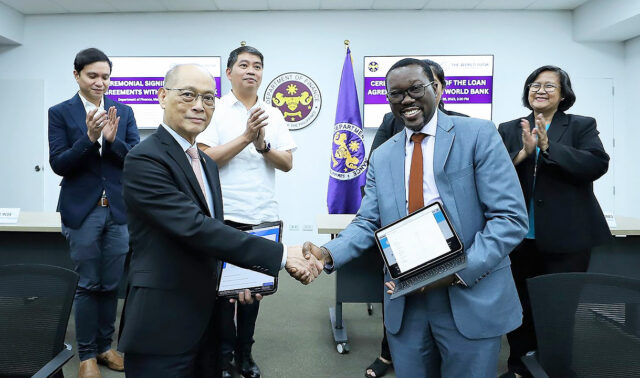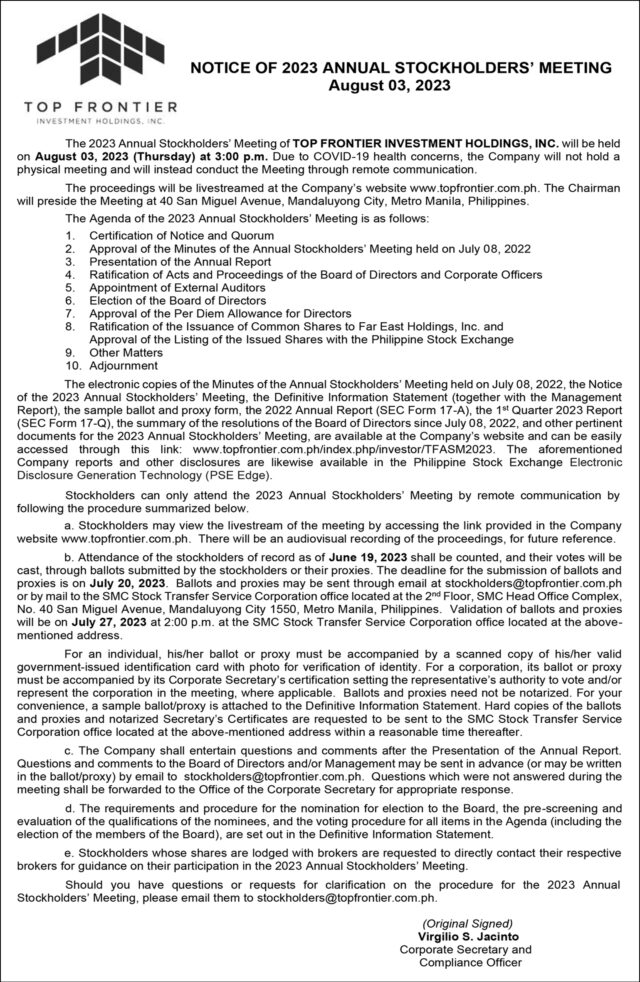PHL, WB ink loan deals worth $1.14B

THE PHILIPPINE government and the World Bank (WB) signed on Monday four loan agreements worth $1.14 billion, including a $750-million loan to support policy reforms on environmental protection and climate resilience.
Finance Secretary Benjamin E. Diokno and World Bank Country Director for the Philippines Ndiamé Diop signed the loan agreements, which would fund government initiatives to boost economic resilience, improve education, strengthen climate resilience and further develop the agriculture and fisheries sectors.
This includes the $750-million Philippines First Sustainable Recovery Development Policy Loan, which was approved by the World Bank earlier this month.
It aims to increase private investment in renewable energy, improve plastic waste management, promote green transport, and mitigate climate-related risks in agriculture.
The loan will also support policies related to the implementation of the Extended Producer Responsibility Act, which requires large enterprises to recover up to 80% of plastic packaging waste by 2028, as well as amendments to the Public Service Act, which allows full foreign ownership in telecommunications, airlines, and railways.
Mr. Diokno and Mr. Diop also signed the $176-million loan for the Philippine Fisheries and Coastal Resiliency (FishCoRe) Project, the $110-million loan for the Teacher Effectiveness and Competencies Enhancement Project (TEACEP), and the $100-million loan for the Mindanao Inclusive Agriculture Development Project (MIADP).
The FishCoRe project aims to enhance fisheries management and production, and boost incomes in selected coastal communities.
The TEACEP project, which was approved by the World Bank last Friday, seeks to enhance learning outcomes in Mindanao by improving access to quality teaching.
Meanwhile, the MIADP seeks to improve agricultural productivity in Mindanao while protecting ancestral domains.
The Finance department said the loan deals were signed using a digital signing platform (DocuSign), which is part of the World Bank’s shift to streamline business processes through digital technology. The World Bank will be using e-signatures as the default modality for the signing of its financing agreements starting July 1.
DIGITAL INFRASTRUCTURE LOAN
Meanwhile, the Philippine government is seeking a $300-million loan from the World Bank to improve its digital infrastructure.
“The project development objective is to improve broadband connectivity, strengthen the resilience of the digital environment, and enhance the digital infrastructure foundations for government service delivery,” the World Bank said in a document uploaded on its website.
The Philippines Digital Infrastructure Project is expected to be approved by the World Bank board on March 28, 2024.
“The Philippines’ digital infrastructure — across dimensions of broadband connectivity, data infrastructure, cloud services, and cybersecurity — is uneven and characterized by gaps in various segments of the network and fragmentation in its overall architecture,” the multilateral lender said.
Over 58 million Filipinos or 52% of the population were found to be “internet poor,” according to the Internet Poverty Index. This is much higher than its regional neighbors such as Malaysia (1%), Indonesia (16%), Vietnam (10%) and Thailand (5%).
Outside of Luzon, the Visayas (63%) and Mindanao (77%) have the highest percentage of individuals without internet access.
“The connectivity component of the project will make investments in the government fiber optic backbone at the national level as well as in middle-mile and last-mile connectivity, providing internet access to people and households in remote areas in Eastern Mindanao,” the World Bank said.
“The project will activate the entire government broadband backbone from the North to the South of the country connecting to two main international landing stations,” it added.
The Philippine government has prioritized the implementation of the National Broadband Plan, which has been delayed in the last few years due to lack of funding.
“The government’s request for development financing is an expression of the need to accelerate necessary investments in the country’s backbone, middle-mile connectivity, and closing remaining last-mile gaps,” the World Bank said.
The project also aims to ramp up cybersecurity capacity and infrastructure, which the World Bank noted are at a “low level.”
Last year, the Philippines ranked 61st in the Global Cybersecurity Index and 89th in the E-Government Development Index.
The project aims to strengthen the national and regional computer emergency response teams and enhance government capacities, and update legal frameworks related to cybersecurity.
However, it also noted that improving cybersecurity will not interfere with the privacy and access to information of citizens.
Also, the project aims to strengthen the government’s data infrastructure. This includes making government data centers “cloud-platform hosting ready.”
“The project beneficiaries are citizens and businesses in the Philippines, benefiting from higher quality and more affordable broadband access in the entire country and in previously unserved or underserved areas, and improved user experiences and lower cost of doing business through improved public service delivery,” the World Bank added.
The Department of Information and Communications Technology will be the lead implementing agency for the project.
As of 2021, the World Bank was the country’s third-largest source of official development assistance (ODA), with loans and grants representing 24% of total ODA or $7.66 billion. — Luisa Maria Jacinta C. Jocson











